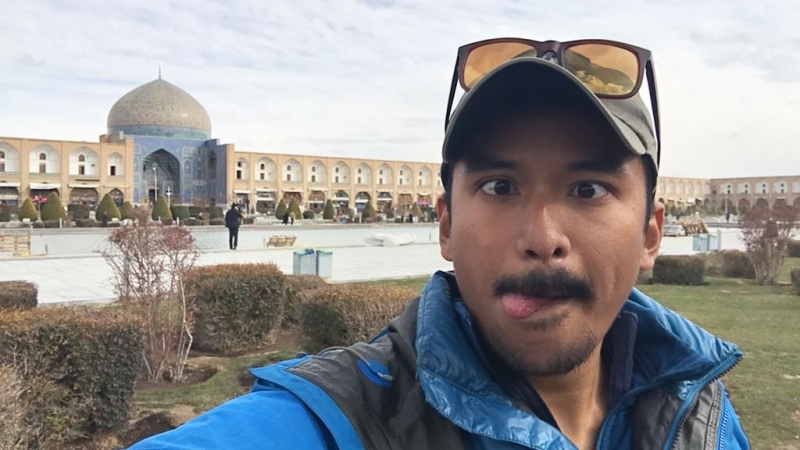What would compel someone to spend a whole month cycling in Iran?
A curious mind and an adventurous soul would be a prerequisite – and Hakim, a 27-year-old hailing from Singapore, ticks those boxes.
Armed with two weeks of planning and a trusty Surly bike he lovingly named Ruby, Hakim landed in Tehran in the beginning of 2017.
He had a route in mind, one that takes him from the bustling capital to the cities of Kashan, Yazd and Shiraz, before looping back to Tehran through Isfahan. Grand mosques, dazzling palaces and winding bazaars await, but in between was always a seemingly endless stretch of road – hauntingly silent, save for the winds and the crunch of gravel. And the unforgiving cold that comes with winter in Iran.

Meet Ruby.
The winter journey into the heart of Iran
Hakim hit the pedals.
He brought with him zero expectations of the country as he pedalled his way from Kashan to Yazd, along undulating hills blanketed lightly in snow. Along the way, Iran unveiled itself to him piece by piece, layer by layer.
In the heart of the country, he found overwhelming kindness – everywhere, locals invited him to their homes or offered him bread and biscuits. Hakim spoke no Farsi but encountered little communication problems. It seemed that many Iranians had a basic grasp of English, and even if they didn’t, creative universal gestures were aplenty. The dust may cloud his vision and the wind may pierce through his bone but as he paddled from town to town, his heart was overflowing with warmth.

Look at the view!
Soon, he settled into the rhythms of long-distance cycling. Hakim is no stranger to this mode of travel. Two years back in 2015, he journeyed overland from Singapore to Chiang Mai on Ruby alongside an Australian friend – a feat that took him a month. A tent, sleeping mat, clothes, stove and some food and water were all he needed with him. The gear added up to about 20 kilograms.
As he cycled along the roads in Iran, he came across small settlements where he was able to restock his necessities. He kept a lookout for heavy vehicles which were the main danger on the road, but those were far and few in between. Wild camping – which basically means to set up camp anywhere – was the way to go for Hakim. When he wasn’t sleeping in a local’s home or a hostel, he simply pitched a tent, bundled in layers, slithered into a sleeping bag and called it a night. Upon waking up, he usually covered sixty to a hundred kilometres in a day – but this is absolutely up to his whims and fancies. Such is the freedom of travelling alone, free from all desires except for those that emanate from within himself.

Ruby getting squeezed into the car boot in Tehran, where Hakim chose alternative means of transport because of the daunting traffic.

Hakim hitched a ride to Yazd on a truck, thanks to this kind man.

The gorgeous view along the road.
Despite travelling alone, Hakim had plenty of company. As locals drive by, many would stop to offer him a ride. Some even insist that he should hop on. On his way to Yazd, Hakim hitched a ride in an orange truck with an affable man named Hamza. He appeared to be making ends meet yet was generous enough to buy Hakim a meal on top of giving him a free ride. This narrative seemed to repeat itself again and again in Iran, embalming the concept of Iranian hospitality that Hakim began to get all too familiar with.
A feast for the tummy, eyes, and the curious mind
When asked about Iranian food, Hakim declares his liking for Doogh and Ghormeh Sabzi. That’s as Iranian as it gets: Doogh, which is a salty yoghurt-based drink, is a much-loved beverage in Iran while Ghormeh Sabzi, a herb stew with meat, is widely touted as the national dish of the country.

The Jameh Mosque in Yazd.

Hakim in Naqsh-e Jahan Square.
On top of enjoying Iranian food, Hakim savoured the sights. He fell in love with Yazd, an ancient city in Central Iran, the moment he pedalled into the courtyard of its majestic Jameh Mosque. Yazd was a joy to explore, with buildings awashed in a muddy beige tinge, labyrinthine alleys with arched ceilings, and a mix of windcatchers and minarets dominating the skyline. Another place that stole his heart was Isfahan’s Naqsh-e Jahan Square. One of the largest squares in the world, it is flanked by Ali Qapu Palace, the Keisaria Gate which leads to the Grand Bazaar, as well as two mosques: Shah Mosque and Sheikh Lotf Allah Mosque. The grandeur of this gem can hardly be described in words but its historical significance rendered it a place on UNESCO’s list of World Heritage Sites.

The dazzling colours in Nasir ol Molk Mosque, also known as Pink Mosque.
Among the stunning attractions he visited, the Nasir Ol Molk Mosque in Shiraz is one that left a deep impression on him. The humble facade of this mosque masks a truly breathtaking interior. When he arrived in the morning, the sunlight streaming through the stained glass windows left a kaleidoscope of colours on the carpeted floor. Above him, the ceilings were laid with intricate tilework which came together to form a bewitching wonderland.

The dusty road to Aboozaid Abad.
Beyond the touristy locales, Hakim found himself taken by the little towns that were yet to be trodden by the tourist feet. One such place was Aboozaid Abad, tucked some forty kilometres southeast of Kashan. There, he had a mini convoy of friendly local kids who followed him around on bicycles and motorbikes as he went about his cycling. Such are the draws of slow travel on two wheels: uncovering the places that buses simply zoom past, and having a sense of connection to the ground and the immediate surroundings. A cyclist is easily able to weave into the narrow paths and satisfy his curiosities.
A country of contradictions
In many ways, Iran was surprising to Hakim. For one, he certainly did not expect to see ladies walking around with nose-job tapes in a country ruled by Islamic laws. But believe it or not, Iran has the highest rate of nose surgery in the world. Hakim witnessed first-hand how Iranians skirt the law when he stumbled upon locals brewing wine at home despite the fact that it’s illegal in Iran to consume – much less produce – alcoholic beverages. In fact, he even encountered a shop in Shiraz that pulled down the shutters just to serve alcohol. As riveting anecdotes like these roll off Hakim’s tongue, it became clear that Iran is so much more than meets the eye. Hakim also felt that, in general, Iranians were more liberal in their mindsets than what many outsiders would presume.
The locals with dreams and ambitions
Not surprisingly then, given the eye-opening insights he glimpsed into the Iranian culture, the main highlight of Iran for him was the people. He remembers the Iranian youth who hosted him in Kashan, the one who wanted to discover Europe on a bicycle like him, and wondered if she managed to settle the troublesome visas. He spoke of the teenager he met in Tehran who shared his dream of studying in the US – a dream that is particularly difficult to be realised now amidst the current political climate. It struck him that oftentimes, all these people who are adversely affected by top-down policies are simply harmless civilians who wish a better life for themselves.
Such stories hit a spot for him and served as a poignant reminder that there are many out there who are simply not as lucky as him because of where they were born. He was acutely aware of the privilege bestowed upon him for holding the Singapore passport which opens borders with few questions asked. Hakim is more than determined not to let this go to waste – travel is a lifelong passion for him, and he intends to continue combing new territories such as the mysterious Wakhan Valley in Afghanistan.
From Hakim to you
Hakim brims with words, and the ones he direct to anyone who’s pondering over making a similar journey is this: Just do it. Be bold. Be brave. At the same time, brace for the worst – even though it’s unlikely to happen.
So journey on, fellow readers. Take the lead from this inspiring traveller and hit the pedals too, be it in Iran or beyond. If you’d like to get in touch with Hakim for any advice or questions, add him up on Instagram @hakkysack.





